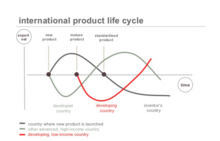Technological gap theory proposes that changes in international trade are dictated by the relative technological sophistication of countries.
Some nations, such as the US or Japan, have a competitive trade advantage because of their ability to innovate. Over time, other countries will bridge a particular gap although the really innovative will have opened others.
Also see: product life-cycle theory
Source:
A Heertje, Economics and Technical Change (London, 1977)
History

Fig.1 The International Product Life Cycle by Raymond Vermon
The development of an explicit technology gap model started with Ponser. The key for the theory is the rate of diffusion of technology. Moving on to 1966, Vernon further extended the technology gap model into the product life-cycle theory.[2] The degree of maturity of the technology became the new key of the dynamic economic trade. Vernon’s theory resonances with the technology gap theory. As Fig1. shows, at the new-product phase, the product is only produced and consumed in the innovating countries, usually the developed countries. But, as the product matures, the imitating countries, usually the developing countries, intervenes the market by underselling the products. The production of the product gradually gets standardized and the innovating countries can no longer monopolize the market.[4]
In 1981, Pasinetti proposed a Ricardian comparative advantage model that emphasizes on the rate of innovation. Later, Dosi and his colleagues affirmed technology gap as the heart of absolute advantage in 1990. Moreover, Dosi et al. complicated the definition of diffusion, which makes a smooth diffusion process does not exist anymore.[5] The new definition now writes as: the “process of learning, modification of the existing organization of production and, often, even a modification of products.”[6]
Between Countries
Technological changes is cumulative, path-dependent, and non-specific for each country. Thus, it is hardly sharable between nations. Nowadays, it can determine the competence of a nation to a great extent, and influence demand conditions and technological policies. As a result, the technology gap theory strongly emphasizes on the role of government in prompting innovations.[2]
United States, as one of most technologically advanced nations in the world, exports a variety of new technology to conquer the global market. Most of the time, other countries acquire the same technology sooner or later. With lower labor costs, U.S. no longer hold the comparative advantage in making the same products. However, U.S. producers can keep on introducing new technology to the markets abroad and new technology gap will be formed during the process.[4]
As long as the new technology is diffused to developing countries, the globalization will have a positive impact on them, otherwise, the domestic market will only be harmed.[6] African countries, for example, Kenya, are currently suffering from the technology gap not only globally but also domestically.[7] Organizations, such as the United Nations, are now working hard to bind such gaps within nations.[8]
Between Companies
Unlike between countries, technological changes between firms are specific. It is can be measured by the ability of the firm to produce and innovate.[3] Companies, such as pwc, offer surveys and solutions to help alleviate the gap between business and technology,[9] which will also lead to enhanced communication and creativity of the whole business, and making the enterprise more competitive in the market.
The 5G is an example demonstrating impact of technology gap on and between businesses. In accordance with the theory, the vice president and global innovation officer at Cisco said that “There is not any one country, one company or one continent that’s going to own 5G…I just don’t want the focus to be all about 5G and who gets to the finish line, the sprint first, because there’s a much longer race after that.”[10]
Limitations
- The theory does not account for the size of technological gaps in a precise manner.[4]
- The theory fails to illustrate why technology gap exists and how it diminishes over time.

I have not checked in here for a while since I thought it was getting boring, but the last several posts are good quality so I guess I will add you back to my everyday bloglist. You deserve it my friend 🙂
Many thanks for Giving us Such a Terrific Info.
I have found great blog posts right here. I like the method you create.
So excellent!
Thanks in favor of sharing such a nice idea, article is nice, thats why i have read it entirely